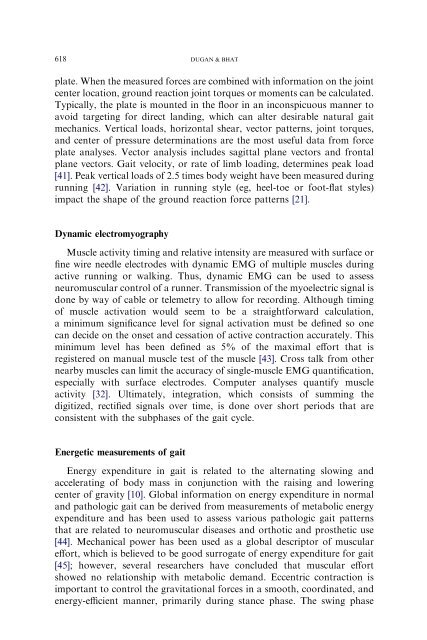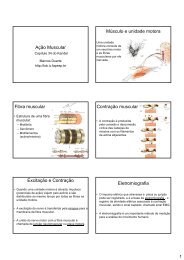Biomechanics and Analysis of Running Gait - De Motu
Biomechanics and Analysis of Running Gait - De Motu
Biomechanics and Analysis of Running Gait - De Motu
You also want an ePaper? Increase the reach of your titles
YUMPU automatically turns print PDFs into web optimized ePapers that Google loves.
618 DUGAN & BHAT<br />
plate. When the measured forces are combined with information on the joint<br />
center location, ground reaction joint torques or moments can be calculated.<br />
Typically, the plate is mounted in the floor in an inconspicuous manner to<br />
avoid targeting for direct l<strong>and</strong>ing, which can alter desirable natural gait<br />
mechanics. Vertical loads, horizontal shear, vector patterns, joint torques,<br />
<strong>and</strong> center <strong>of</strong> pressure determinations are the most useful data from force<br />
plate analyses. Vector analysis includes sagittal plane vectors <strong>and</strong> frontal<br />
plane vectors. <strong>Gait</strong> velocity, or rate <strong>of</strong> limb loading, determines peak load<br />
[41]. Peak vertical loads <strong>of</strong> 2.5 times body weight have been measured during<br />
running [42]. Variation in running style (eg, heel-toe or foot-flat styles)<br />
impact the shape <strong>of</strong> the ground reaction force patterns [21].<br />
Dynamic electromyography<br />
Muscle activity timing <strong>and</strong> relative intensity are measured with surface or<br />
fine wire needle electrodes with dynamic EMG <strong>of</strong> multiple muscles during<br />
active running or walking. Thus, dynamic EMG can be used to assess<br />
neuromuscular control <strong>of</strong> a runner. Transmission <strong>of</strong> the myoelectric signal is<br />
done by way <strong>of</strong> cable or telemetry to allow for recording. Although timing<br />
<strong>of</strong> muscle activation would seem to be a straightforward calculation,<br />
a minimum significance level for signal activation must be defined so one<br />
can decide on the onset <strong>and</strong> cessation <strong>of</strong> active contraction accurately. This<br />
minimum level has been defined as 5% <strong>of</strong> the maximal effort that is<br />
registered on manual muscle test <strong>of</strong> the muscle [43]. Cross talk from other<br />
nearby muscles can limit the accuracy <strong>of</strong> single-muscle EMG quantification,<br />
especially with surface electrodes. Computer analyses quantify muscle<br />
activity [32]. Ultimately, integration, which consists <strong>of</strong> summing the<br />
digitized, rectified signals over time, is done over short periods that are<br />
consistent with the subphases <strong>of</strong> the gait cycle.<br />
Energetic measurements <strong>of</strong> gait<br />
Energy expenditure in gait is related to the alternating slowing <strong>and</strong><br />
accelerating <strong>of</strong> body mass in conjunction with the raising <strong>and</strong> lowering<br />
center <strong>of</strong> gravity [10]. Global information on energy expenditure in normal<br />
<strong>and</strong> pathologic gait can be derived from measurements <strong>of</strong> metabolic energy<br />
expenditure <strong>and</strong> has been used to assess various pathologic gait patterns<br />
that are related to neuromuscular diseases <strong>and</strong> orthotic <strong>and</strong> prosthetic use<br />
[44]. Mechanical power has been used as a global descriptor <strong>of</strong> muscular<br />
effort, which is believed to be good surrogate <strong>of</strong> energy expenditure for gait<br />
[45]; however, several researchers have concluded that muscular effort<br />
showed no relationship with metabolic dem<strong>and</strong>. Eccentric contraction is<br />
important to control the gravitational forces in a smooth, coordinated, <strong>and</strong><br />
energy-efficient manner, primarily during stance phase. The swing phase



